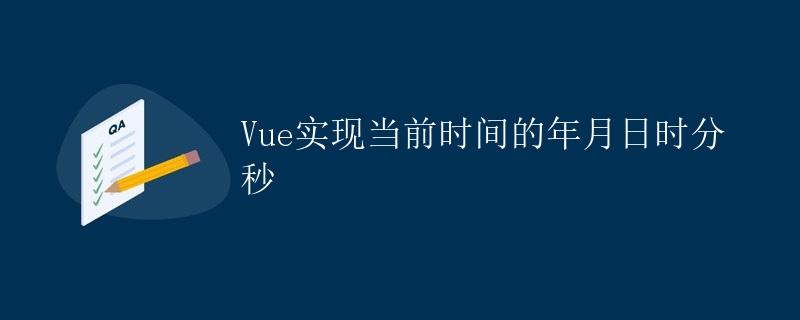Vue实现当前时间的年月日时分秒

Vue是一个流行的JavaScript框架,用于构建用户界面。它使用声明式语法,使得开发者可以轻松地构建动态的Web应用程序。在本文章中,我们将详细介绍如何使用Vue来实现显示当前时间的年、月、日、时、分和秒。
1. 创建Vue应用
首先,我们需要创建一个基本的Vue应用。在HTML文件中,我们引入Vue库,并创建一个根元素来绑定Vue应用。
<!DOCTYPE html>
<html>
<head>
<title>Vue实现当前时间的年月日时分秒</title>
<script src="https://cdn.jsdelivr.net/npm/vue/dist/vue.js"></script>
</head>
<body>
<div id="app">
<!-- 这里显示当前时间的年月日时分秒 -->
</div>
<script>
var app = new Vue({
el: '#app',
});
</script>
</body>
</html>
2. 显示当前时间
为了显示当前时间,我们可以使用Vue中的数据绑定和表达式。在Vue实例中,我们可以定义一个变量来保存当前时间,并在HTML中绑定它。
<div id="app">
<p>当前时间: {{ currentDate }}</p>
</div>
<script>
var app = new Vue({
el: '#app',
data: {
currentDate: ''
}
});
</script>
此时,我们的应用将显示一个空的时间。为了获取当前时间,我们需要在Vue实例初始化时设置一个计时器,并在每秒钟更新当前时间。
<script>
var app = new Vue({
el: '#app',
data: {
currentDate: ''
},
mounted: function() {
setInterval(() => {
this.currentDate = new Date();
}, 1000);
}
});
</script>
现在,在浏览器中打开页面,您将看到一个不断更新的当前时间。
3. 格式化当前时间
尽管我们已经能够显示当前时间,但它的显示格式可能不符合我们的需求。为了更好地满足我们的需求,我们可以使用Vue过滤器来格式化当前时间。
Vue过滤器可以用于在模板中对数据进行处理。我们可以定义一个过滤器来格式化日期和时间。
<div id="app">
<p>当前时间: {{ currentDate | formatDateTime }}</p>
</div>
<script>
var app = new Vue({
el: '#app',
data: {
currentDate: ''
},
filters: {
formatDateTime: function(value) {
var date = new Date(value);
var year = date.getFullYear();
var month = date.getMonth() + 1;
var day = date.getDate();
var hour = date.getHours();
var minute = date.getMinutes();
var second = date.getSeconds();
return year + '-' + month + '-' + day + ' ' + hour + ':' + minute + ':' + second;
}
},
mounted: function() {
setInterval(() => {
this.currentDate = new Date();
}, 1000);
}
});
</script>
现在,我们的应用将以”年-月-日 时:分:秒”的格式显示当前时间。
4. 添加动态效果
为了增加一些动态效果,比如文字渐变或闪烁,我们可以使用Vue的内置动画系统。
首先,我们可以为当前时间的元素添加一个CSS类,以便我们可以在样式中定义动画效果。
<div id="app">
<p :class="{ 'fade-in': isFadingIn, 'flash': isFlashing }">当前时间: {{ currentDate | formatDateTime }}</p>
</div>
在Vue实例中,我们可以定义相关的数据属性来控制动画效果。
<script>
var app = new Vue({
el: '#app',
data: {
currentDate: '',
isFadingIn: false,
isFlashing: false
},
filters: {
formatDateTime: function(value) {
// ...
}
},
mounted: function() {
setInterval(() => {
this.currentDate = new Date();
this.isFadingIn = !this.isFadingIn;
this.isFlashing = !this.isFlashing;
}, 1000);
}
});
</script>
在CSS中,我们可以定义相应的动画效果。
.fade-in {
animation: fade-in 1s;
}
.flash {
animation: flash 1s infinite;
}
@keyframes fade-in {
0% {
opacity: 0;
}
100% {
opacity: 1;
}
}
@keyframes flash {
0% {
opacity: 1;
}
50% {
opacity: 0;
}
100% {
opacity: 1;
}
}
现在,我们的应用将在每秒钟渐变一次,并闪烁一次。
5. 综合示例
下面是一个综合示例,包括显示当前时间、格式化时间和添加动态效果的完整代码。
<!DOCTYPE html>
<html>
<head>
<title>Vue实现当前时间的年月日时分秒</title>
<script src="https://cdn.jsdelivr.net/npm/vue/dist/vue.js"></script>
<style>
.fade-in {
animation: fade-in 1s;
}
.flash {
animation: flash 1s infinite;
}
@keyframes fade-in {
0% {
opacity: 0;
}
100% {
opacity: 1;
}
}
@keyframes flash {
0% {
opacity: 1;
}
50% {
opacity: 0;
}
100% {
opacity: 1;
}
}
</style>
</head>
<body>
<div id="app">
<p :class="{ 'fade-in': isFadingIn, 'flash': isFlashing }">当前时间: {{ currentDate | formatDateTime }}</p>
</div>
<script>
var app = new Vue({
el: '#app',
data: {
currentDate: '',
isFadingIn: false,
isFlashing: false
},
filters: {
formatDateTime: function(value) {
var date = new Date(value);
var year = date.getFullYear();
var month = date.getMonth() + 1;
var day = date.getDate();
var hour = date.getHours();
var minute = date.getMinutes();
var second = date.getSeconds();
return year + '-' + month + '-' + day + ' ' + hour + ':' + minute + ':' + second;
}
},
mounted: function() {
setInterval(() => {
this.currentDate = new Date();
this.isFadingIn = !this.isFadingIn;
this.isFlashing = !this.isFlashing;
}, 1000);
}
});
</script>
</body>
</html>
这样,我们就完成了使用Vue实现显示当前时间的年、月、日、时、分和秒的文章。
 极客笔记
极客笔记